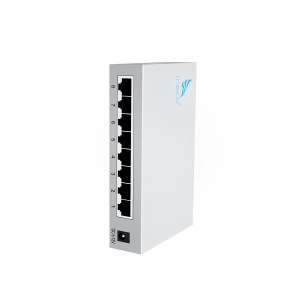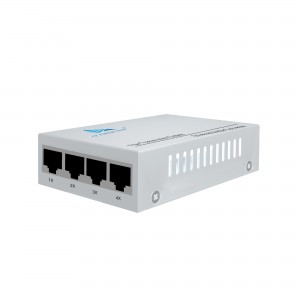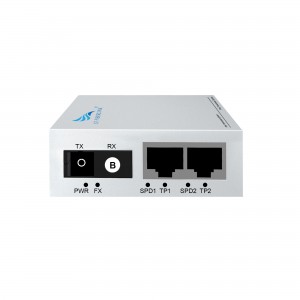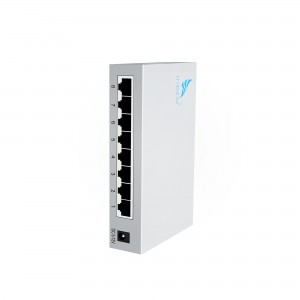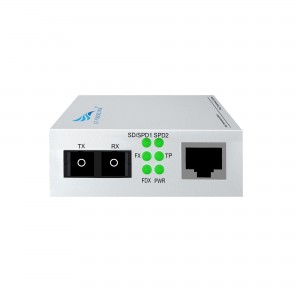9-port 10/100M Media Converter (Single-mode Dual-fiber SC)
9-port 10/100M Media Converter (Single-mode Dual-fiber SC)
Product Features:
Introducing Fiber Media Converters: Enhancing Connectivity with Cutting-Edge Technology
At Huizhou Feishichang Photoelectric Technology Co., Ltd., we are proud to be a leading professional manufacturer of industrial communication products in China. With a passion for innovation and a commitment to excellence, we developed a breakthrough product that revolutionized connectivity – the Fiber Optic Media Converter.
This state-of-the-art switch combines the latest technological advancements with exceptional performance, making it an essential tool for businesses looking to optimize their network infrastructure. Fiber optic media converters are designed for industrial and commercial applications, seamlessly integrating the world of traditional Ethernet and fiber optic networks.
Featuring 1 fiber and 8 electrical single-mode dual-fiber capabilities, the converter ensures fast and reliable data transmission over long distances, eliminating the limitations associated with traditional copper-based networks. By converting Ethernet signals to optical signals, this versatile device allows data to be transmitted over fiber optic cables, providing enhanced bandwidth and improving network efficiency.
Optical media converters are very user-friendly, with a host of features that simplify operation. Its intuitive 4-digit dial simplifies configuration and allows users to easily adjust settings to their specific requirements. Equipped with an SC interface, the converter provides a secure and efficient connection, ensuring seamless data transmission without any signal loss.
To further enhance usability, the fiber optic media converters feature dynamic LED indicators that provide real-time feedback on the status of the device. These indicators allow users to monitor link activity, speed and power availability at a glance, simplifying troubleshooting and minimizing downtime.
One of the outstanding features of fiber optic media converters is their remarkably low power consumption. With the increasing focus on energy efficiency, our products address these issues, providing sustainable and environmentally friendly solutions. By consuming less electricity, the converter reduces operating costs and contributes to a greener future.
As a leading manufacturer in this field, we are committed to providing high-quality products to meet customers’ ever-changing needs. Our team of experts work tirelessly to ensure that each fiber optic media converter meets the highest standards of performance, reliability and durability. With our commitment to excellence, you can trust our products will exceed your expectations.
Fiber optic media converters are just one of our extensive product lines, which include cloud-managed industrial switches, PoE switches, Ethernet switches, fiber optic transceivers and wireless transmission devices. Our comprehensive product portfolio caters to different industry needs and provides tailor-made solutions for various applications.
At Huizhou Feishichang Optoelectronics Technology Co., Ltd., we are more than just a manufacturer; we are committed to being your trusted partner in the field of industrial communications. With a wide range of products, systematic equipment and comprehensive services, we aim to provide cutting-edge solutions that provide seamless connectivity for your business.
Join us on our journey to become a world-class industrial communication expert. Discover the power of fiber optic media converters and unlock the true potential of your network infrastructure. Experience unrivaled performance, efficiency and reliability with our innovative products. Believe that Huizhou Feishichang Photoelectric Technology Co., Ltd. will revolutionize your connectivity solutions. Contact us today and let us take your network to new heights.
What This Product Does
◇ The CF-1028SW-20 is a media converter designed to convert 100BASE-FX fiber to 100Base-TX copper media or vice versa. Designed under IEEE 802.3u 10/100Base-TX and 100Base-FX standards, the CF-1028SW-20 is designed for use with single-mode fiber cable utilizing the SC-Type connector. The CF-1028SW-20 supports longwave (LX) laser specification at a full wire speed forwarding rate. It works at 1310nm on both transmitting and receiving data.
◇ Other features of this module include the ability to be used as a stand alone device (no chassis required), Auto MDI/MDI-X for TX port, and front panel status LEDs. The CF-1028SW-20 will transmit at extended fiber optic distances utilizing single-mode fiber up to 20 kilometers.
Other Features
◇ Besides, this media converter can be used as a standalone device (no rack required) or used with CF FIBERLINK’s CF-2U14 rack for auto MDI/MDI-X in TX port in which duplex mode is automatically negotiated.
technical parameter:
| Model | CF-1028SW-20 | |
| Interface Characteristics | ||
| Fixed Port | 8* 10/ 100Base-TX RJ45 port
1* 155M uplink SC fiber port |
|
| Ethernet Port | 10/ 100Base-TX auto-sensing, full/half duplex MDI/MDI-X self-adaption | |
| Twisted Pair
Transmission |
10BASE-T: Cat3,4,5 UTP(≤100 meter)
100BASE-T: Cat5e or later UTP(≤100 meter) |
|
| Optical Port | Default optical module is single-mode dual-fiber 20km, SC port | |
| Wavelength/Distance | single mode: 1310nm 0~40KM ,1550nm 0~120KM | |
| Chip Parameter | ||
| Network Protocol | IEEE802.3 10BASE-T, IEEE802.3i 10Base-T,IEEE802.3u 100Base-TX, IEEE802.3u 100Base-FX, IEEE802.3x | |
| Forwarding Mode | Store and Forward(Full Wire Speed) | |
| Switching Capacity | 1.8Gbps | |
| Buffer Memory | 1.33Mpps | |
| MAC | 1K | |
| LED Indicator | Fiber | FX(green) |
| Data | 1/2/3/4/5/6/7/8(green) | |
| Power | PWR (green) | |
| Power | ||
| Working Voltage | AC:100-240V | |
| Power Consumption | Standby<1W, Full load<5W | |
| Power Supply | DC:5V/2A industrial power supply | |
| Lightning protection &Certification | ||
| Lightning protection | Lightning protection: 4KV 8/20us, Protection level: IP30 | |
| Certification | CCC;CE mark, commercial; CE/LVD EN60950;FCC Part 15 Class B; RoHS | |
| Physical Parameter | ||
| Operation TEMP | -20~+55°C;5%~90% RH Non condensing | |
| Storage TEMP | -40~+85°C;5%~95% RH Non condensing | |
| Dimension (L*W*H) | 140mm* 80mm*28mm | |
| Installation | Desktop, CF-2U14 slot rack | |
Product Size:
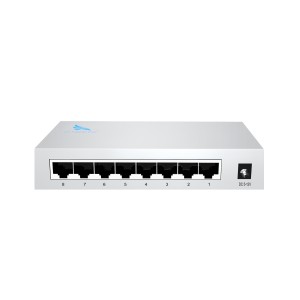
Product application diagra:

How to choose a fiber optic transceiver?
Optical fiber transceivers break the 100-meter limitation of Ethernet cables in data transmission. Relying on high-performance switching chips and large-capacity caches, while truly achieving non-blocking transmission and switching performance, they also provide balanced traffic, isolation and conflict. Error detection and other functions ensure high security and stability during data transmission. Therefore, fiber optic transceiver products will still be an indispensable part of actual network construction for a long time. So, how should we choose fiber optic transceivers?
1. Port function test
Mainly test whether each port can work normally in the duplex state of 10Mbps, 100Mbps and half-duplex state. At the same time, it should be tested whether each port can automatically select the highest transmission speed and automatically match the transmission rate of other devices. This test can be included in other tests.
2. Compatibility test
It mainly tests the connection ability between the optical fiber transceiver and other devices compatible with Ethernet and Fast Ethernet (including network card, HUB, Switch, optical network card, and optical switch). The requirement must be able to support the connection of compatible products.
3. Cable connection characteristics
Test the fiber optic transceiver’s ability to support network cables. First, test the connection ability of Category 5 network cables with lengths of 100m and 10m, and test the connection ability of long Category 5 network cables (120m) of different brands. During the test, the optical port of the transceiver is required to have a connection capability of 10Mbps and a rate of 100Mbps, and the highest must be able to connect to a full-duplex 100Mbps without transmission errors. Category 3 twisted pair cables may not be tested. Subtests can be included in other tests.
4. Transmission characteristics (transmission loss rate of data packets of different lengths, transmission speed)
It mainly tests the packet loss rate when the optical fiber transceiver optical port transmits different data packets, and the connection speed under different connection rates. For the packet loss rate, you can use the test software provided by the network card to test the packet loss rate when the packet size is 64, 512, 1518, 128 (optional) and 1000 (optional) bytes under different connection rates. , the number of packet errors, the number of packets sent and received must be more than 2,000,000. Test transmission speed can use perform3, ping and other software.
5. The compatibility of the whole machine to the transmission network protocol
It mainly tests the compatibility of fiber optic transceivers to network protocols, which can be tested in Novell, Windows and other environments. The following low-level network protocols such as TCP/IP, IPX, NETBIOS, DHCP, etc. must be tested, and the protocols that need to be broadcast must be tested. Optical transceivers are required to support these protocols (VLAN, QOS, COS, etc.).
6. Indicator status test
Test whether the status of the indicator light is consistent with the description of the panel and the user manual, and whether it is consistent with the current status of the fiber optic transceiver.









